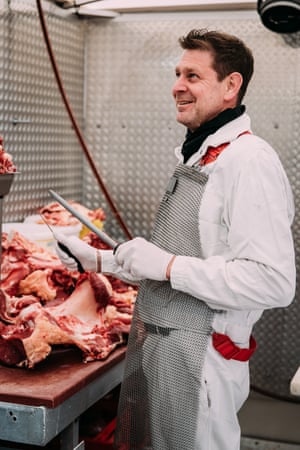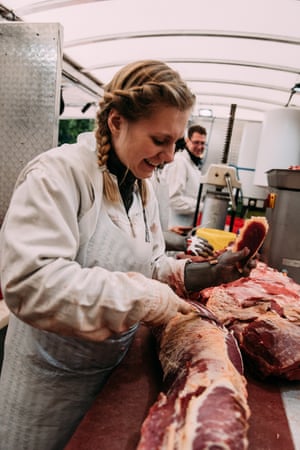Inside the white trailer parked up by the farm, the small team headed by Matthias Kurten are moving fast.
Their work has a rhythmical soundtrack: a bandsaw cutting through bones, fat slopped into buckets, murmurs of chatter and knives being sharpened. Diced meat for stew, steaks, soup stock, mince and liver are sealed with the inhale of a vacuum-packer, stamped by a sticker machine, and land in plastic crates with a thud.
Ten days earlier Kurten had come to the farm and slaughtered seven cows and calves; the carcasses are hanging in a nearby cooling wagon. Now his team are back to process the meat. Kurten, a softly spoken man with a ready laugh, is Germany’s only mobile butcher: a one-stop shop for livestock slaughter and meat processing.
In Germany, slaughterhouses – as they are in the US and elsewhere in Europe – are increasingly being seen as coronavirus hotspots, as hundreds of workers have tested positive across the country in recent weeks. A plant in Dissen, Lower Saxony, is the latest to close after 92 workers tested positive.
The cases have thrown the industry into the spotlight – particularly the close working and living conditions for employees. The federal government will this week discuss stricter measures to reduce the spread of the virus.

But so far the coronavirus hasn’t impacted Kurten’s business. “We actually have more work,” he says. “Our customers are buying more.” Partly he thinks people want to stock up and buy more to distribute among friends to help them out. Cleaning products have been harder to get hold of, but being a smaller operation means it’s easier to maintain safe distancing.
Founded in 2002, Kurten’s butcher is a curious anomaly in an industry characterised by ever greater economies of scale. Around the world slaughterhouses are getting fewer and bigger. “We are doing the exact opposite,” Kurten reflects, a saw wedged in a swaying carcass at his side. “And it’s working really well.”
Over the course of a year he visits roughly 350 farms, usually slaughtering one to four cows, two or three pigs and as many as 38 sheep on each, and butchering them to the farmers’ specifications – often, as is the case today, with their help.
At the heart of his business lies the conviction that animals should be slaughtered on the farm. “This means they are calm,” he says. “They can eat up until the last moment. Mostly they don’t understand what is happening at all.”
This is why farmers such as Andrea Schmitz, who has been a client for a decade, chooses Kurten over the cheaper alternative of an industrial slaughterhouse. “The animals are born here in the barn with us and run around our fields … They aren’t driving off in a truck,” she says.
Francesca Porta of the advocacy organisation Eurogroup for Animals adds: “It solves the problem of the stress of loading into a truck, the long journey to a slaughterhouse, and the unloading where the animal doesn’t know where it is and then has to wait [for slaughter].”
Earlier this year the Guardian reported that as the live animal export trade booms across Europe, animals are travelling ever-longer distances, while the European Commission is failing to fully implement its own transport welfare regulations. Longer journeys are linked to a trend across Europe for fewer and larger slaughterhouses, run by an increasingly small number of large commercial players.
“In Germany we have a very strong concentration in the slaughtering industry,” says Katrin Wenz, from Friends of the Earth Germany. A few smaller slaughterhouses can still be found in states such as Lower Saxony, she adds, but in places like Brandenburg companies have to transport animals over long distances. More than half the pigs in Germany, for example, are slaughtered by just three companies.

“It became increasingly hard for smaller companies to compete,” says Wenz, citing low profit margins and high EU requirements. “More and more gave up because the big industrial slaughterhouses could slaughter increasingly cheaply and efficiently.”
Kurten is not slaughtering any animals today, but when he does the farmer is usually present. His methods differ depending on the animal: a bolt gun for cattle, electric stunning for pigs and sheep. He remembers the butcher visiting his family farm when he was younger, and the village shops that slaughtered animals themselves rather than have meat delivered. Since starting his training at 16, he has witnessed the industry reconfigure: “I worked [back then] in a small shop – but these aren’t around any more.”
He believes, like many others, that the key turning point was the EU hygiene regulations that came into force in 2006. Kurten was able to find enough investment to ensure his business could comply with the new standards but many, he recalls, gave up. And while he still feels the pressure of high costs – including machinery and vets to oversee slaughter – Kurten says the business keeps growing. He’s booked up months ahead.
Kurten points to the Natur Fleisch (natural meat) stickers on the packages. It describes, he says, the personal relationships between the customer, farm and butcher, and that the product comes from animals “that in the summer are able to stand in the field”.
“An email is sent out saying a cow has been slaughtered and five hours later everything will be sold,” he says. “And this is sent locally, among a circle of friends and acquaintances – not throughout Germany.” Nothing, he’s happy to say, ends up in the supermarket.
In recent years the German slaughterhouse industry has been criticised for low pay and poor working conditions, particularly for the thousands of eastern European migrant workers it employs.
“One of the biggest challenges for the slaughter industry today, as it will be in the next 10-15 years, is finding enough staff,” says Thomas Bernhard, from the German Union of Food and Catering.

In a series of interviews with German slaughterhouse workers, sociologist Marcel Sebastian at the Europa-Universitat Flensburg, documented how they perceived the cultural shift from honest craft to source of moral stigma. “They struggled with this dramatic shift in public perception,” says Sebastian.
While many see him as a curious niche, Kurten remains optimistic. Dozens of red crates are filling up in preparation for tomorrow’s customers – a startling amount from a few animals. Kurten finds particular satisfaction in wasting as little as possible.
Shiva, his portly dog, follows him as he works, eagerly awaiting scraps. Kurten works six days a week, and it will be dusk before he attaches the trailer to his car and drives home to his second rottweiler, Achilles. Is he concerned about more people rejecting meat altogether in the future?
“No, not at all,” he says. “If we were only producing half – or a third – [of the meat] we do now then we would be doing it right. We already have too much. A little bit less would be good.”